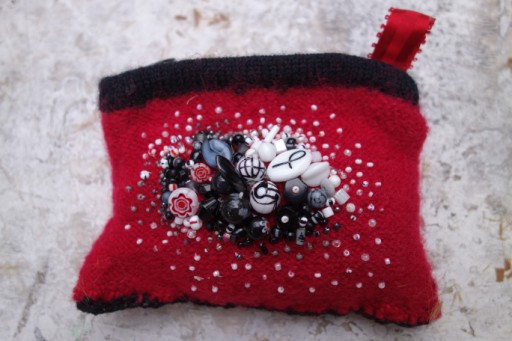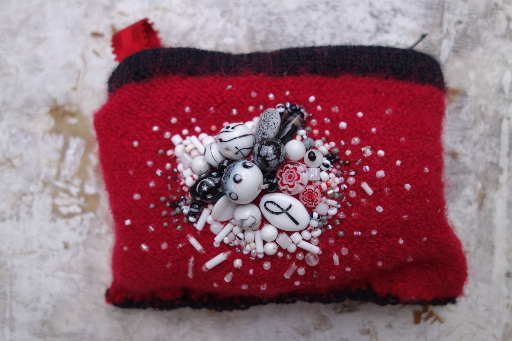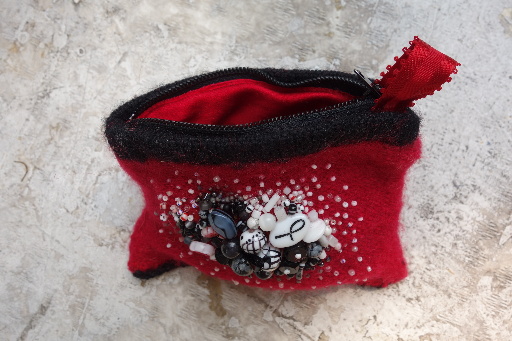Like the rhyolite/unakite pouch that started this series of beaded embroidery posts, the red, black and white necklace I made in July also yielded lots of leftovers, especially lampwork. I had a felted sweater in just the right colour, and I reasoned that nice thick, softly felted wool would be both strong and easy to embroider—and like my stockings, wouldn't even require me to use an embroidery hoop! I also started incorporating what I thought of as the“sprinkling technique” that I first started using the brown silk pouch.
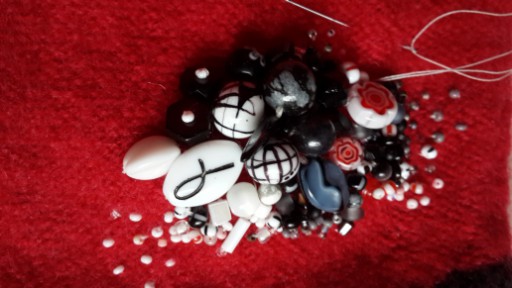
In progress. 03 August 2015. Howlite, snowflake obsidian, artisan lampwork, pressed/vintage, shell, swarovski, seed and bugle beads. Nylon thread on red and black wool.
I have for the last couple of years or so been haphazardly been teaching myself to insert zippers, with varying success. After the difficulties with the last bag, I sewed the zipper in first before investing all that time doing the embroidery. And remembered to put in a loop. I thought I did a nice job, if I do say so myself:) Yay, finally getting it.
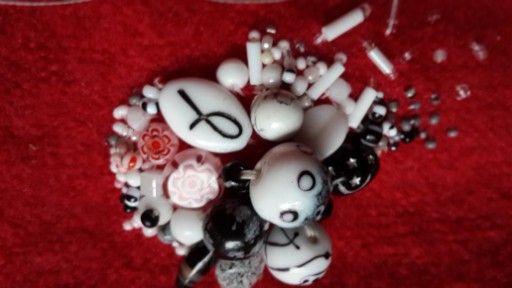
I wanted to do more of the ‘spread’ style on this piece as well, but kept filling in, at least with the bigger beads. That did at least use a lot of them, which was sort of the goal.
While I was in Alaska, I was lucky enough to learn a bit about Tlinglit (pronounced Klinkit, more or less) culture at the Totem museum in Ketchikan from a very passionate native guide;[1] as well as a performance of some native songs and stories. One of the performers directed me a shop supporting local schools, where I picked up a manual on Tlinglit and Haida art. Reading the book (and listening to the Native woman at the museum) it appeared that adapting to the style for a personal memento would probably be acceptable.
It took a very short time indeed to realize that I simply haven't the understanding to translate even the simplest of Tlinglit designs into beaded embroidery on this scale. I did gain a much better sense of their art is put together.[2]
Front in that the focal bead, which unfortunately was too big to put into the necklace, as it was the owner's fave. Naturally, this pouch is too small to fit the necklace, or I'd send it along as a storage bag. C'est la vie.
Though I was happy with the job I did inserting the zipper and the lining, the same cannot be said of the bottom edge. I figured, after various zipper disasters, that it would be hard, and sewing up the bottom a piece of cake. The reverse actually happened. I must have tried—and ripped out—3 or 4 efforts, and finally gave up. It was definitely a case ‘good enough, move on, try something new with the next one.’
[1]Sort of a misnomer. Totems, like Tibetan sand paintings, are supposed to be ephemeral; that is to rot back into the ground, in place. But collectors were snitching so many of them that native people felt compelled to house them in a museum as the next best alternative to protect them from thieves and vandals.
[2]Such that I've now say I've gotten to ‘advanced beginner’ level. Appropriation is justifiably a sensitive subject, but my gut level response is that if you really take the time and effort to dig into a culture—and to be able to reproduce/produce [your own] designs in that idiom takes some effort—folks can often get on board with that. It's when you chop out bits and pieces of their work to paste out of context to be ‘cool’, without bothering to understand its underlying principles, and blend them naturally with your own, that people get pissed. Perhaps my favourite totem was a photograph of a ‘mixed’ scandinavian/tlingit style which utterly charmed me. My point being that everyone, Tlingkit included, are influenced by other artisans. However, I realize that others may consider this rationalization.
Unless otherwise noted, text, image and objects depicted therein copyright 1996--present sylvus tarn.
Sylvus Tarn